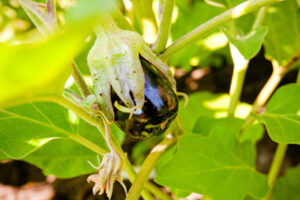Tidily arranged on a sunny patch of wide open space behind Brady Educational Center near the corner of Woodlawn and Goodrich avenues lies the UST Stewardship Garden, a community garden project led by University of St. Thomas undergraduates. Dr. Adam Kay, a St. Thomas biology professor who advises the project, believes the garden and the university are filling a unique and worthy niche.
“The reason why this community garden project is so exciting is because we’re doing biodiversity research on a level that can have an impact on the field and where undergraduates are playing a prominent role in it," he said.
Even better, Kay added, the products of their research are fresh vegetables rather than the plastic and chemical waste produced by many projects in the life sciences. Kay's group donates these vegetables to low-income communities.
A project in biodiversity and giving
The UST Stewardship Garden is more than just a garden. It’s a group project that gives students a forum to conduct research on biodiversity in a meaningful way, whether it’s taking a leadership role or performing data analysis and presenting the results.
The 80-by-80-foot garden holds 32 plots containing bell peppers, cabbage, cucumbers, green beans, eggplant, potatoes and two varieties of tomatoes. The plots were divided in half to study two different variables: organic fertilizer − coffee grounds from Owen’s Science halls’ Beaker's Coffee Cart composted using worms − versus synthetic fertilizer, and mixed-species assemblages (plots containing many kinds of plants) versus monoculture assemblages.
The goal this summer was to determine if biodiversity has an impact in urban gardens.
The results of their study were presented at the Ecological Society of America national conference held in Austin, Texas, in August.
Kay added that the project embraces another key focus of St. Thomas: service learning. In its second season, the garden project more than doubled the amount of fresh vegetables it donated to local food shelves, providing more than 900 pounds of produce to the Dorothy Day Center in St. Paul and Neighbors, Inc. in South St. Paul.
Ashela Richardson, a junior environmental science major who co-leads the project with senior justice and peace studies/communication and journalism major Aaron Hays, said, “This research has opened my eyes to the possibilities of being a steward in my community.” She noted the gratitude of those who’ve received their garden’s bounty: "The volunteers at the food shelf were very excited to have fresh produce to use in the kitchen instead of simply canned and frozen goods. A diverse mix of fresh produce is not something they generally receive from donors."
Addressing a biodiversity crisis
Kay describes the students' research as “a pretty standard yet important ecological experiment designed to see how mixed-species assemblages affect productivity,” or yield of produce. He added, "The importance of this research is that there’s this biodiversity crisis across the planet where a third of the species that have been reviewed are classified as threatened or something more severe than that … on the edge of extinction.” He and the students involved with the project hope it will galvanize people to care about the crisis and become involved in creating solutions.
Kay explained, “The way that modern agriculture is done is through monocultures, which simplifies the farming process in some ways, but it results in none of the value that comes out of complementary plants around each other,” such as managing pests and diseases. He added, “If we can show in an agricultural setting that mixed-species assemblages can increase productivity, we can bring some awareness to the fact that having multiple species in natural systems also can increase productivity in those systems. It’s a value that feeds back on human well-being.”
The future of the project
Kay envisions a network of gardens all designed under a similar protocol so they can have comparable data across multiple sites. "Ideally," he said, "we can get external funds so we can hire an organizer to facilitate UST student participation." His hope is that local junior and senior high schools will conduct similar experiments on their own grounds, and St. Thomas students would serve as mentors.
"The project is an opportunity for having young people figure out what science is all about: asking questions and collecting data and using the evidence to find answers for themselves instead of just asking somebody what the answer is," he said.
In the coming years, students will track the development of the garden's soil chemistry over time, planting the same plant combinations and monocultures in the same plots using the same type of fertilizer.
Richardson, who this week is wrapping up her first season working in the garden, is looking forward to making improvements next year based on what she learned over the summer. An avid gardener, she would like to incorporate raised beds and basic trellis systems to support the plants as they grow as well as build the volunteer base. This year the bulk of the volunteers came from the Biology Club, the Green Team, Students for Justice and Peace, and Multicultural Student Services.
And because of its public location on the edge of campus, the garden will continue to bolster the university's relationship with the surrounding community. "We've had neighbors come through all the time and talk to the students about what's happening. They're really enthusiastic and warmly received," Kay said.
Learn more about the UST Stewardship Garden on its Facebook page.







